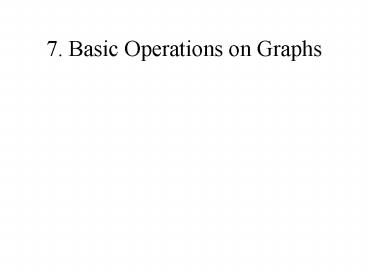7. Basic Operations on Graphs PowerPoint PPT Presentation
1 / 23
Title: 7. Basic Operations on Graphs
1
7. Basic Operations on Graphs
2
Basic Operations on Graphs
- Deletion of edges
- Deletion of vertices
- Addition of edges
- Union
- Complement
- Join
3
Deletion of Edges
- If G (V,E) is a graph and e 2 E one of tis
edges, then G - e (V,E e) is a subgraph
of G. In such a case we say that G-e is obtained
from G by deletion of edge e.
4
Deletion of Vertices
- Let x 2 V(G) be a vertex of graph G, then G - x
is the subgraph obtained from G by removal of x
grom V(G) and removal of all edges from E(G)
having x as an endpoint. G x is obtained from
G by deletion of vertex x.
5
Edge Addition
- Let G be a graph and (u,v) a pair of
non-adjacent vertices. Let e uv denot the new
edge between u and v. By G G uv G e we
denote the graph obtained from G by addition of
edge e. In other words - V(G) V(G),
- E(G) E(G) e.
6
Graph Union Revisited
- If G and H are graphs we denote by G t H their
disjoint union. - Instead of G t G we write 2G.
- Generalization to nG, for an arbitrary positive
integer n - 0G .
- (n1)G nG t G
- Example
- Top row C6 t K9
- Bottom row 2K3.
7
Graph Complement
- The graph complement Gc of a simple graph G has
V(Gc) V(G), but two vertices u and v are
adjacent in Gc if and only if they are not
adjacent in G. - For instance C4c is isomorphic to 2K2.
8
Graph Difference
- If H is a spanning subgraph of G we may define
graph difference G \H as follows - V(G\H) V(G).
- E(G\H) E(G)\E(H).
G
H
G\H
9
Bipartite Complement
- For a bipartite graph X (with a given
biparitition) one can define a bipartite
complement Xb. This is the graph difference of
Km,n and X Xb Km,n \ X.
Xb
X
10
Empty Graph Revisited.
- The word empty graph is used in two meanings.
- First Meaning . No vertices, no edges.
- Second Meaning En Knc. nK1. There are n
vertices, no edges. - E0 0. G will be called the void graph or
zero graph.
11
Graph Join
- Join of graphs G and H is denoted by GH and
defined as follows - GH (Gc t Hc )c
- In particular, this means that Km,n is a join of
two empty graphs En and Em.
12
Exercises 7
- N1. Show that for any set F µ E(G) the graph G-F
is well-defined. - N2. Show that for any set X µ V(G) the graph G-X
is well-defined. - N3. Show that for any set X µ V(G) and any set
F µ E(G) the graph G-X-F is well-defined. - N4. Prove that H is a subgraph of G if and only
if H is obtained from G by a succession of
vertex and edge deletion.
13
8. Advanced Operations on Graphs
14
Cone and Suspension
- The join of G and K1 is called the cone over G
and is denoted by Cone(G) GK1. - The join G(2K1 ) is called suspension.
15
Examples
- Any complete multipartite graph is a join of
empty graphs. - The cone Cone(Cn) is called a pyramid or wheel
Wn. - The octahedral graph is the suspension over C4.
It can be written in the form - O3 (2K1)(2K1)(2K1).
- Construction can be generalized to
- On (2K1)(2K1) ...(2K1)
16
Subdivision
- Let e 2 E(G) be an edge of G. Let S(G,e) denote
the graph obtained from G by replacing the edge e
by a path of length 2 passing through a new
vertex. Such an operation is called subdivision
of the edge e.. - Let F be a subset of E(G), then S(G,F) denotes
the graph obtained from the subdivision of each
edge of F. In the case F E, we drop the second
argument and S(G) denotes the subdivision graph
of G. - Graph H is a general subdivision of graph G, if H
is obtained from G by a sequence of edge
subdivisions.
17
Graph Homeomorphism
- Graphs G and H are homeomorphic, if they have a
common subdivision. - Graph G is topologically contained in a graph K,
if there exists a subgraph H of K, that is
homeomorphic to G.
18
Matching
- Edges with no common endvertex are called
independent. A set of pairwise independent edges
is called a matching.
19
Maximal Matching
- A matching that cannot be augmented by adding new
edges is called a maximal matching.
20
Perfect Matching
- Proposition Let M be a matching of a graph G on
n vertices. Then M n/2. - A matching M with M n/2 is called a perfect
matching.
21
Abstract Simplicial Complex
- K µ P(S) is an abstract simplicial complex if
for each s 2 K and each t µ s it follows that t 2
K. - On the left
- K , a, b, c, d, e, f, g, h, ab, ad, abd, bc,
be, bce, bd, ce, df, dg, de, eh
a
d
b
f
c
e
g
h
22
Line Graph L(G)
- Two edges with a common end-vertex are incident.
Incidence is a binary relation on the edge set
E(G). - Line graph L(G) has the vertex set E(G), while
the edges of L(G) are determined by the incidence
of edges in G.
23
Examples
- The top row depicts the Heawood graph and its
fourvalent linegraph. - The bottom row depicts the Petersen graph and its
line graph.

